THE UNWAVERING MISSION
The mission of the Sisters of Notre Dame de Namur, that of education and of standing with those who are marginalized, is constant. While history has swirled around them, while insurrections, depressions, pandemics and all manner of tumult and upheaval have upended the existing order — from revolutionary France to colonial Africa to the COVID crisis in our own time — the Sisters have pushed forward, always forward.
And when you think about it, when is living out the Gospel most needed?
I can tell you that now — in these days of trial — it’s needed by prisoners reaching out for someone to talk with. It’s needed by students in the
developing world for whom education is the one and only path pulling them away from the slums. It’s needed by the families of special needs children who have seen the programs for their children shuttered for fear of the virus.
Now is a time when the Sisters’ good works are imperative. Now is a time when vulnerable people are most likely down for the count if not for a helping hand. You, partnering with the Sisters, represent this helping hand – not just here but in places as far away as Kenya and the Democratic Republic of Congo. In the next few pages, we’ll show you how that’s happening.
THEY CALL HIM BRIGHT.
Whether the name was given in a hope-filled moment, or as a cruel joke, or given for some other reason — is uncertain. His father has trouble with language, and has developmental disabilities. The same is true with his grandmother. His mother is dead.
Bright, for a long time, resided in a mud-walled hut. The floor was mud as well. The roof was grass. In the same hut lived the grandmother. The father’s whereabouts were generally unknown.
This was all in Malava, which is a hard day’s drive from the Kenyan capital of Nairobi. Malava itself, according to Mike Gable, the Mission Director of the Cincinnati Archdiocese, “is in a tough spot.”
“It’s a way out place,” he says.
“It’s not what you’d call a boom town,” says Sister of Notre Dame de Namur Gerry Bolzan.
KEVIN MANLEY Director of Development

The big trucks make it dusty hauling out the sugarcane. A new road is supposed to make it better, but hasn’t. There are a few stores. A market. A church. A small hospital. A great many huts.
And a mile or so out, the Notre Dame Education Centre.
Which brings us to Bright. Each day Bright’s grandmother carried him on her back to market. There, they begged for food. Some, the “well-wishers” as Sister Esther Onditi calls them, responded.
Sister Esther heads up the Sisters' work in Malava. She and the other Sisters know Bright well.
Some years ago they saw Bright was of school age and persuaded the grandmother to bring him to
school. There would be no fee for his studies, and two meals besides. The two meals clinched it. And so each day the grandmother brought Bright upon her back to the gate, whereupon, at the insistence of the Sisters, he walked inside. And each afternoon the grandmother returned, stooped for Bright to climb on once more, and off they’d go to the market.
CROSS CURRENTS
CONTINUED ON PAGE 4
BELOW
Students pray before beginning the day.
3
There are 300 children at the Notre Dame Education Centre. Some, like Bright, are in the most dire of situations. A good number are from single-parent households. All are from families who are poor. Which is one of the reasons Mike Gable was in town — to bring people from the United States who were in a position to help financially, or who knew others who could.
“Only a few children are able to pay something,” says Sister Esther. “Some can only depend on God’s grace,” she says, “and the wellwishers.”
The Notre Dame Education Centre has grown as money has become available. It began with a fourroom preschool and today runs through the eighth grade. While Sister Esther is the Head of School, she is also an English teacher, a music teacher, a home science teacher and a French teacher. She is assisted by five other Sisters of Notre Dame de Namur and twelve lay staff.
The Kenya Province of the Sisters was established in the 1960s not long after the country established its independence from Great Britain. In Congregational terms, it’s a new province compared to others such as Ohio (1840) or the Democratic Republic of Congo (1894). Sister Rosemary Wack, an Ohio Sister and a member of the Rome-based Sisters of Notre Dame Congregational Leadership Team, conducted an exploratory visit in early 1965, then later returned as a missionary. Since then, the Province has grown to 26 professed Sisters,
five novices (two of whom are from Zimbabwe), and eight postulants.
Sister Gerry Bolzan, herself from the Ohio Province, has seen a lot of this growth, and has played a large role in making it happen. After twenty years teaching biology at Notre Dame High School for Girls in Chicago and Mount Notre Dame High School in Cincinnati, she packed her bags for another career — this time as a missionary — and has been in Kenya since 2005. She’s served as Novice Director and most recently as Director of Sisters in Initial Commitment.
“There seems to be a strong identification with St. Julie among Kenyan women,” she says. “The poverty, the persecution, the illness — they can relate to this.”
Most, too, can relate to Malava.
“Everybody identifies with the village, not Nairobi,” says Sister Gerry, even if they now live there. And so, from the Sisters’ main convent in the ‘Little Vatican’ area of the capital, Sister Gerry often sends the Sisters in formation back to the village, back to Malava. There, they hitch rides on pickipickis the mile to the school, pickipicki being Swahili for motorcycle.
Sister Esther, five years ago, and while in formation, was one of these Sisters.
In the Time of Covid "The children say, ‘I fear I will get corona,'” says Sister Esther. The school, beginning in spring of last year, and by decree of the Kenyan government, was only allowed to
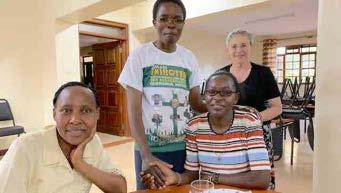
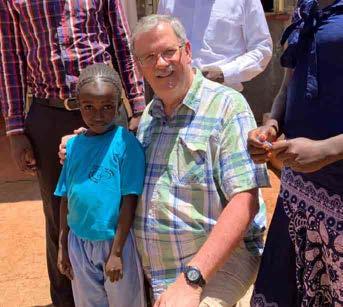
teach grades four and eight. It was the same in other Kenyan schools. Families relocated because they couldn’t pay the rent. Jobs dried up.
It’s been much the same in Nairobi.
“It’s tense, there’s always tension,”
says Sister Gerry. “You have to think a lot, you have to think twice. It’s just here constantly.” Four students live with Sister Gerry, each going to school in the capital. “They are exhausted,” she says.
Yet still, in Malava, the Sisters are providing children with two meals a day. Still they are going out into the community, as prudence allows, to visit children and families.
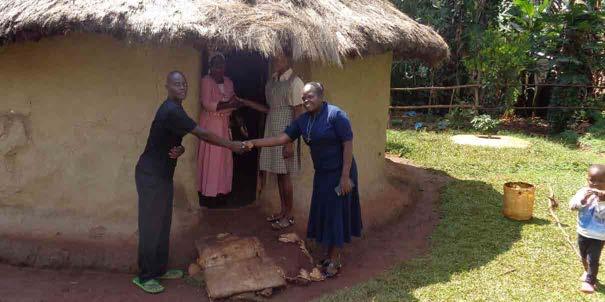
“It’s our work,” says Sister Esther. “We come to teach. But there is the extra mile to give these children what they need.”
Some of the things they need currently, now that the school has resumed a full, if tentative schedule, are hand-washing stations, masks and a tent so they can attend classes outside.
But regardless, they are doing their best, says Sister Esther.
“The weather is not friendly, it is very hot. And when it is hot with
5 4 CROSS CURRENTS CONTINUED ON PAGE 6
SISTERS OF NOTRE DAME DE NAMUR
Sister Susan Libendi,Coordinator of Social Outreach at Notre Dame Educational Center, visits the parents of students at their home.
Sister Gerry, Director for Sisters in Initial Commitment (right) works with members of the Kenya formation team: Sister Lucy Musembi (left) works with Novices; Sister Praxides Awino (center) leads the Postulants; Sister Elizabeth Sichangi (2nd right) is a social worker and vocation promoter.
Mike Gable, Director Archdiocese of Cincinnati Mission Office, with student who recited the essay, I Am A Teacher, for Archdiocese of Cincinnati visitors.
the masks, it is not easy to maintain them.” But the children are doing it. “They always have their masks on, which is contrary to the adults.”
One of the children, Maureen, lived in conditions similar to Bright — mud house, mud floor, grass for a roof. She is five now. When she was two she was abandoned by a roadside. A woman walked by, saw Maureen, and brought her into the home of mud walls. She notified the authorities who said they’d
investigate, but who never did. And so the woman kept Maureen as best she could — for years — sharing her food and shelter, and each day going the distance to the river to draw water. Her only income was as a casual farm laborer.
“She digs,” Sister Esther says, “then she gets something. And the house, it was a trouble to them, the rain coming in.
“And so we asked, ‘what help can we give you?’ We expected it to be
about the house, but she said, ‛no, get this child an education.’”
And that’s what the Sisters have done. Maureen is in Kindergarten now. She receives two meals each day. There is no fee for tuition, and the Sisters have purchased her clothes.
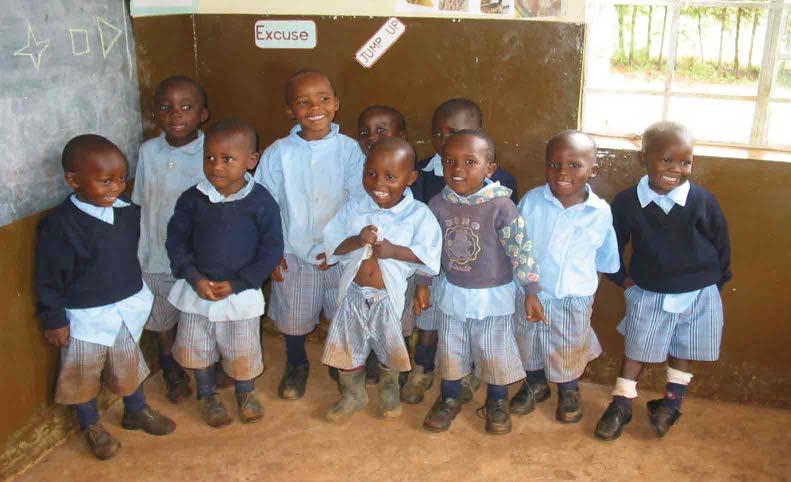
“Before she was very rough, she would fight anyone,” Sister Esther says. “But not now.”
When jetliners fly high in the sky coming out of Nairobi, Maureen
stops what she is doing, looking up. She wants to be a pilot.
“This is a very intelligent girl,” says Sister Esther. “We believe she will achieve her dream.”
The Interconnectedness of Notre Dame
With jet travel, internet, WhatsApp on every Sister’s cellphone, the geographic world of Notre Dame is as interconnected as ever. Mike Gable flies from
Cincinnati. Sisters from Ohio and the rest of the world travel back and forth to Kenya. Women from Zimbabwe profess vows in a nation two thousand miles away. But an interconnectedness often referenced by Sisters speaks more to a relationship spanning centuries, and is that relationship to Sisters who have come before — and to St. Julie.
“Most of our Sisters worked with children who were poor,” says Sister Esther. “It reminds us of where we all came from. And they depended on the well-wishers to move ahead. That is still the same.”
“I love sharing about her [St. Julie’s] life,” says Sister Gerry. “I feel a little like the one telling how things were, how it was. And it gives me joy to see her life in the life of young people and to see her example motivating them, and to see some of the young Sisters I worked with taking over roles of leadership. It just gives me such joy!
“I can’t predict my longevity but as long as I can make a contribution…,” Sister Gerry says, trailing off — a contribution to the formation of Sisters and to children like Bright. Bright is growing and now in boarding school away from Malava. The Sisters are paying his way. They’ve paid too for his shoes, his clothes, his books. They pay for his milk he is required to bring, and for medical checkups. No one is quite sure of his age. The official who gave him a birth certificate looked him carefully over, considered, and said, “The age he is, is the age I will give him.”
And so it is he’s on a set path of education and no longer riding his grandmother’s back. Instead of handouts, he has his sights on being a doctor.
“So I can inject them,” he says, “instead of them injecting me.”
7 6 CROSS CURRENTS
“Only a few children are able to pay something. Some can only depend on God’s grace and the well-wishers.”
—SISTER ESTHER
Students at Notre Dame Educational Centre arrive joyful each morning, excited to be at school.
PRAYER SERVICE REMEMBERS
SISTER DOROTHY STANG
The Sisters of Notre Dame de Namur held a virtual prayer service February 12 to close out the 15th Anniversary Year of the assassination of Sister Dorothy Stang by wealthy landowners in the Brazilian Amazon.
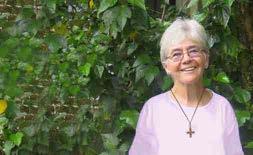
The prayer service included the participation of two Sisters who worked alongside Sister Dorothy: Sister Joan Krimm and Sister Jo Anne Depweg. Sister Elizabeth Bowyer also took part. Sister Elizabeth was the Ohio Province Provincial who received the news of Sister Dorothy’s death. The service was opened by Archbishop Daniel Schnurr, of the Cincinnati Archdiocese.
Discussion followed the prayer service, and included interviews of Sisters Jane Dwyer and Kathryn Webster, who also worked with Sister Dorothy and who remain in Brazil carrying on the work of empowering homesteaders in their struggles with wealthy landowners; a reflection by Samuel Clements, who produced a documentary on Sister Dorothy’s work in the year before she was killed (The Student, the Nun and the Amazon); and a reflection by Evan Mack, who composed an opera in Sister Dorothy’s memory.
Action steps suggested by the prayer service organizing committee include the planting of trees and the tending of community gardens, with produce donated to people who are poor. A link to the recorded service and discussion can be found at the Sisters’ Ohio Province website: www.sndohio.org/sisterdorothy/anniversary-happenings
Live the Good Volunteer Mary Heilers with her husband, Alan

A GOOD HEART IN THE YEAR OF COVID

Mary Heilers has long known the Sisters of Notre Dame de Namur. She’s known them as a little girl growing up in Cincinnati across the street from the Mount Notre Dame convent, she’s known them as a student at Mount Notre Dame High School (and later as a parent of two girls attending that same school), and she’s known them as a volunteer in their ministries.
Now, during the pandemic, and in her position as an outreach coordinator in her parish, she’s organized a letter-writing campaign, sending letters to elderly Sisters including those in the Mount Notre Dame Health Center. She’s participated in a Sisters’ Live the Good community service event, has sewn masks for Sisters, and is overseeing a youth project to make fleece scarves for Sisters in the Health Center.
“The Sisters laid the foundation for me wanting to help people,” Mary says, “and for stepping up to what I was called to do.”
LIVE THE GOOD
is sponsoring a Cincinnati event during Lent to assist food-insecure families during the pandemic. The event will include the making and delivering of lunches, to be followed by an interactive Zoom call on Wednesday, March 10 at 7 p.m. regarding the underlying causes of hunger and poverty. For more information and to register, visit: www.sndohio.org/join-us/live-the-goodvolunteers .
A SISTER'S DREAM
Sister Margaret Goode, almost every day for 40 years, walked past the crumbling infrastructure of the Jesuit waterworks in the village of Pelende, Democratic Republic of Congo (DRC). She saw it while studying French sitting in a small desk side by side with fourthyear girls. She saw it while teaching chemistry. She saw it on the ball field coaching intramural sports. All of it was plain. The crumbling concrete stanchions, the corroded water tanks, the broken pipes.
And Sister Margaret wasn’t quiet about it.
In Pelende, DRC, electricity came first. Solar panels were installed in 2010 on the convent roof, and are now being relocated to a ground array to allow for expansion. Efficient, long-lasting lithium-ion storage batteries are replacing lead-acid batteries. Albeit slowly, electricity in addition to that needed for light, refrigeration and communication — is coming online in sufficient capacity to pump and purify water.
“We’re getting to the end of the solar end of it,” says Sister Lorraine Connell, General Treasurer of the Sisters of Notre Dame de Namur. “But we have kids still walking around with buckets on their heads, and you can’t purify water in buckets. The labor cost of getting water to families is just incredible.”
Once this system had supplied water not only to the village but to the Sisters’ compound and schools, and likewise to the Jesuits and their school. But no longer. Instead, long lines of children snaked down the hill to the spring, and snaked back again, all of them carrying buckets. And doing so at the cost of study time, and time spent simply being children.
It was Sister Margaret’s dream, through all those 40 years, and even as civil war rolled over the border from Rwanda, to restore this water system.
And now it’s happening.
Through the Sisters’ Clean Water for Life Project, water and electricity are being provided to villages in Nigeria, Kenya and the western portion of DRC.
So instead of the spring, a new supply system will rely on a 300-foot borehole with water pumped to storage tanks, through water purification systems and ultimately into the arteries of a distribution system serving the village; the Sisters’ schools, convent and prenatal clinic; and the Jesuits’ school. The total expense is $388,600, with the Sisters and Jesuits working collaboratively on how best to raise the funds needed.
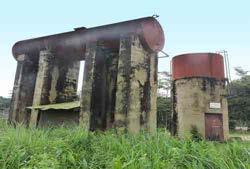
“The resources are now assembling to make this happen,” says Sister Lorraine. “It’s such a small amount for the amount of good it will do.”
Sister Margaret, in the DRC in 2011, said, “Our missions are all for the poor. Here the poor are all around us.” And while Sister Margaret didn’t have the resources in her own lifetime to make a new water system a reality, she kept pushing it, kept it always in the forefront.
“She took no prisoners,” says Sister Lorraine.
9 8 CROSS CURRENTS SISTERS OF NOTRE DAME DE NAMUR
.
The water tanks at Pelende need a thorough cleaning and the interiors recoated.
DEAR FRIENDS,
SISTER
JOAN KERRIGAN
SNDdeN
Formerly
Marie Eleanor
DEC 16, 1933 –
AUG 22, 2020
Eternal rest grant unto them, O Lord, and let perpetual light shine upon them. May their souls, and all the souls of the faithful departed, through the mercy of God, rest in peace. Amen.
SISTER ROSEMARY DONOHUE
SNDdeN
Formerly
John Margaret
MAY 1, 1942 –
SEP 17, 2020
SISTER CATHERINE CHARLES HENDREN
SNDdeN
NOV 21, 1937 –
SEP 22, 2020
SISTER MARY MARGARET FISCHER
SNDdeN
Formerly
Catherine Joan
JUN 28, 1927 –
DEC 17, 2020
SISTER GWEN KOZA
SNDdeN
Formerly Rose Julie
MAY 04, 1927 –
DEC 29, 2020
SISTER SHAWN MARIE MAGUIRE
SNDdeN
SEP 8, 1939 –
SEP 17, 2020
SISTER PATRICIA MURRAY
SNDdeN
Formerly
William Marie
FEB 10, 1926 –
JAN 9, 2021
The Sisters of Notre Dame De Namur remain committed to our worldwide mission to spread the goodness of God and to minister where others may not choose to go. We are so grateful for our donors and friends who support us. Recently, a second pandemic relief bill was signed into law. This latest installment of COVID-19 relief and stimulus includes tax-wise incentives that might encourage you to continue supporting the Sisters and their work even in these challenging circumstances.
As you plan your year, you might want to take these 2021 income tax changes into consideration:
• For non-itemizers, a $300 deduction for cash gifts to qualified charitable organizations (no donor advised funds or supporting organizations).
• For itemizers, an increased deduction limit for charitable gifts of cash from 60% to 100% of AGI with a five-year carryover.
SISTER DIANE REED










SNDdeN
Formerly
Mary Peter
JUL 24, 1932 –
SEP 29, 2020
SISTER ANNE DENISE BLAKE
SNDdeN
AUG 14, 1929 –
JAN 5, 2021
Note: Sadly, two Sisters of Notre Dame de Namur died as a direct result of Covid-19. As of January 7, 2021, all Sisters at the Mount Notre Dame Health Center have tested negative.
SISTER MARY JO D’AMICO
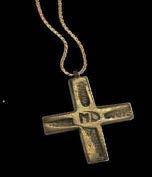
SNDdeN
Formerly
Francis Michele
MAY 26, 1931 –
JAN 12, 2021
• Increased deduction limit on corporate contributions from 10% to 25%.


We understand that your love of the Sisters comes from your generosity and your heart and that you don’t give to the Sisters and other charities because of potential tax incentives. Nevertheless, good fiscal management requires that we keep up on the ever changing tax regulations. As always, we are grateful for you.
SISTER DAMIENNE GRISMER
SNDdeN
Formerly
Damien S.H.
JUL 6, 1929 –
JAN 15, 2021
If you would like more information on how to support the Sisters in ways big or small, please do not hesitate to reach out to me at khadden@ohsnd.org or 513-679-8106. Moving forward, we know that God is always with us.
The Sisters continue to pray for you. Please pray for them.
KAREN HADDEN Associate Director of Development

10
CROSS CURRENTS
SISTER GENEVIEVE MORAN SNDdeN Formerly Matin Marie FEB 22, 1926 –JAN 8, 2021
SISTERS OF NOTRE DAME DE NAMUR
On Your Smartphone Scan For Remberance Information
In March 2019, Archdiocese of Cincinnati Mission Director, Mike Gable, hosted a trip to Africa with several members of the Archdiocese: Deacon Royce, of the African American Ministries office, and his wife Nor-Rita Winters; and Christine and Todd Marallen, who are involved in prison ministries. While in eastern Africa, Mike and his group joined Sister Gerry Bolzan in Nairobi and journeyed to the Notre Dame Education Centre in Malava, Kenya.

The school was opened in 2010 in rural Kenya with six Sisters serving 300 students from early childhood to class 8. Most of the students’ parents are peasant farmers with very little income. The school’s motto, Educating for Life, attracts many students to a learner friendly approach to education, different from the exam-oriented system in other Kenyan schools.
Address Service Requested
facebook.com/SistersOfNotreDamedeNamurOhio
youtube.com/c/SistersofNotreDamedeNamur
twitter.com/SNDdeNOhio

instagram.com/sndohio
linkedin.com/company/sisters-of-notre-dame-de-namur



US ON SOCIAL MEDIA + THE WEB
FOLLOW
SAVE THE DATE FOR OUR STREAMING STAY HOME ENJOY DONATE JOIN US ONLINE � THURSDAY, MAY 13, 2021 � 12:00 PM EDT PARTNERS IN ACTION EVEN T SNDOHI O. ORG
CINCINNATI MISSION OFFICE DIRECTOR VISITS KENYA
ABOVE
Sister Gerry Bolzan and Mike Gable with primary school teachers at the Notre Dame Educational Centre in Malava, Kenya, located just north of the equator.































